the Ngorongoro Conservation Area
The Ngorongoro Conservation Area works towards the conservation of the wildlife in and around the Ngorongoro Crater, both the caldera and the rim.
The name, “Ngorongoro”, according to our guide, Huruma, has an interesting background…it is supposed to be the Masai version of the sound of the cow-bells as they graze! I must confess, in that case I would have thought of words like Tingting or Tinkletinkle…but if “go-rong-go-rong” was the way the Masai heard it…!
The rim of the crater is at a height of about 7000 ft, and so, at this time of the year, it was pretty cold out there!The vegetation at the rim is pretty much the kind of jungle that one would see here in the Malnad region of Karnataka…moist deciduous jungle.
Our hotel was perched on the rim of the crater, and as you could see in the photo I posted yesterday, one can see to the lake at the bottom of the caldera from there. Once, on safari, we descend into the plains of the bottom of the caldera, one can see the crater rim (well, it looks more like hills surrounding the plains!) all around the vast savannah grassland.
All the animals that once descended into the bowl of the caldera now reside there with a few exceptions which move in and out. Hence, the Ngorongoro Conservation Area is like a kind of Noah’s Ark of animals..as KM remarked, God’s gift to the Tanzania Tourist Board! The species variety is remarkable…but since there are no tall acacia trees, there are no giraffes either.
Here we are, entering the NCA on the evening of the 23rd July;
It was so misty, that the sighting of the leopard within 15 minutes of this photograph was a great bonus. Of course, the light was very poor and photographs were not possible…but the leopard stayed, rather confused, by the side of the road for about ten minutes, going around, up and down, during which time we got quite a good look at it!
We checked into the hotel, and early the next morning, (of course, taking time to capture that wonderful sunrise!), went off into the crater bed for the safari.
Here’s a snap of a cap in the hotel souvenir shop (probably made in Taiwan!), detailing the Big Five, as tourists like to call these mammals.
Of the five on that cap, we only got to see four…since we didn’t want to take any special effort to see the rhinos unless we happened to spot them, we didn’t bother (we can see them in our own country, in Assam or Arunachal Pradesh!). There are only 25 rhinos in all, so this is not surprising! If we had wanted to, we could have asked to be taken to them, as each rhino is now fitted with a radio device in its horn and watched…but somehow, we didn’t feel like tracking them down like that!
And of the four that we did see, both our sightings of the LEOPARDS– rather unrecongnizable on that cap!– (once in the NCA, and the second time in a distant tree in Lake Manyara) were in such low-light conditions that we could not take photographs. Indeed, of the two safari vans, the other one which contained my nieces and sisters-in-law (we were ten, in two vans) never got to see the leopards at all, on either occasion!
Even our CHEETAH sightings were at long-distance, on the first occasion, nearly a mile away, when two of them lounged at ease in the grass, watching two ostriches in a mating dance…and the second time,not much closer, when two cheetahs were feasting on a gazelle in the Serengeti National Park. So you are certainly not going to see any spots-on-the-cheetah shots here!
But that’s only the “Big Five”….to us, everything else…from the AUGUR BUZZARD to the ZEBRA…everything was fascinating!
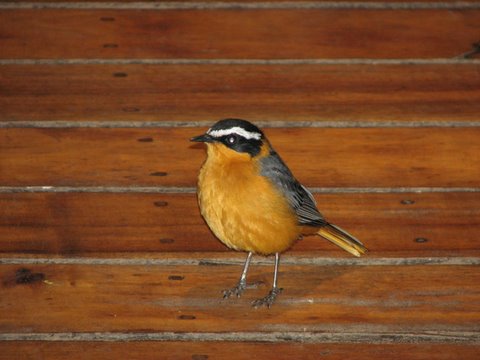 Soon, we were on the road, passing this Masai woman:
Soon, we were on the road, passing this Masai woman:
 And then we started seeing the typical savannah-growing FLAT-TOP ACACIA trees, often with large numbers of WEAVER BIRDS' nests in them:
And then we started seeing the typical savannah-growing FLAT-TOP ACACIA trees, often with large numbers of WEAVER BIRDS' nests in them:
 Everywhere, there were also huge stands of these cactus-like EUPHORBIA CANDELABRUM, some with flowers on them, too:
Everywhere, there were also huge stands of these cactus-like EUPHORBIA CANDELABRUM, some with flowers on them, too:
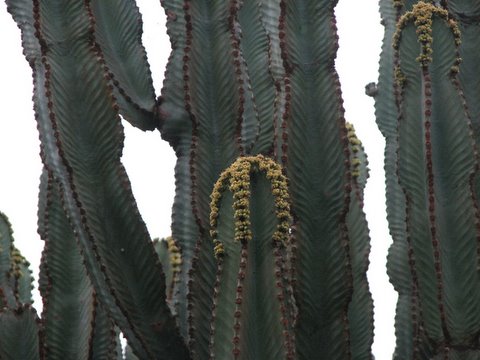 Then we started sighting various birds and animals...here are the YELLOW-THROATED and CHESTNUT-BELLIED SANDGROUSE:
Then we started sighting various birds and animals...here are the YELLOW-THROATED and CHESTNUT-BELLIED SANDGROUSE:
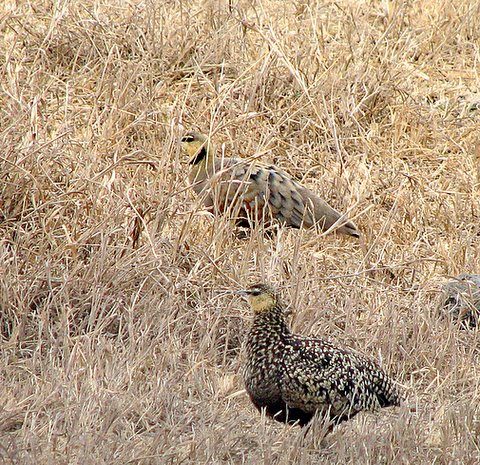 Along came some ZEBRAS....
Along came some ZEBRAS....
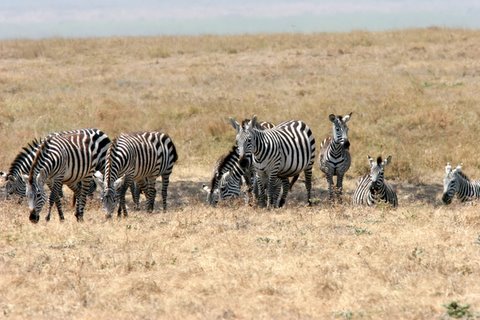 And here are two together, grazing companionably:
And here are two together, grazing companionably:
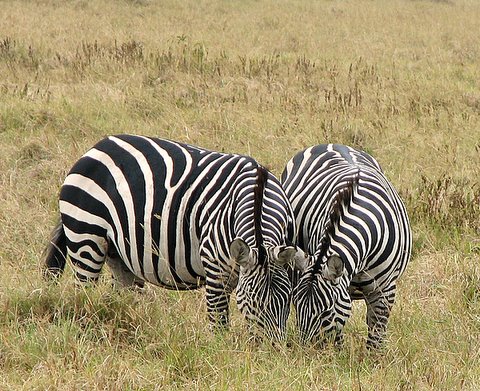 And then came that other iconic image of Africa, a tusker under an Acacia tree:
And then came that other iconic image of Africa, a tusker under an Acacia tree:
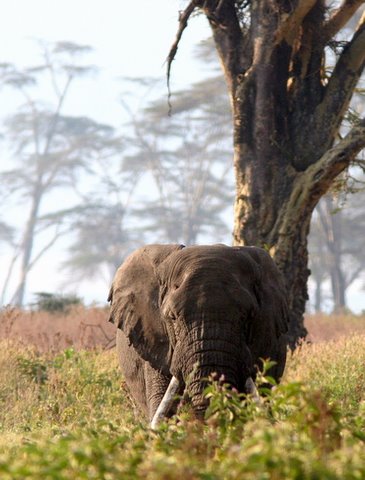 Apparently, both male and female African elephants have tusks...rather confusing for us Asians. Huruma drove up our van quite near lone tuskers sometimes...I told him that would be a total no-no over here!
It was really mind-blowing to see both herbivores and carnivores apparently co-existing on that plain...we are so used to our jungle-with-animals-hiding kind of wildlife, that the idea of all animals, predators and prey, being in plain sight all the time, was a little difficult to accept!
Here's a HYENA, looking up at us, and then relaxing and going off to sleep in the sunshine:
Apparently, both male and female African elephants have tusks...rather confusing for us Asians. Huruma drove up our van quite near lone tuskers sometimes...I told him that would be a total no-no over here!
It was really mind-blowing to see both herbivores and carnivores apparently co-existing on that plain...we are so used to our jungle-with-animals-hiding kind of wildlife, that the idea of all animals, predators and prey, being in plain sight all the time, was a little difficult to accept!
Here's a HYENA, looking up at us, and then relaxing and going off to sleep in the sunshine:
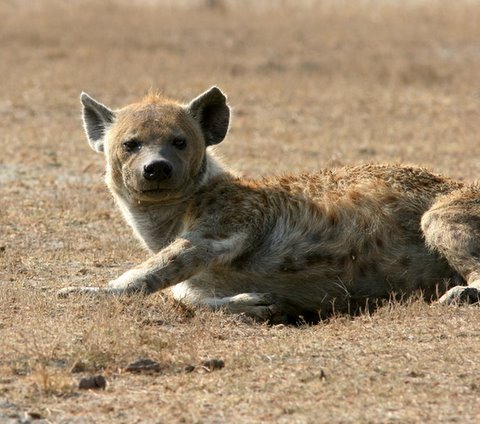
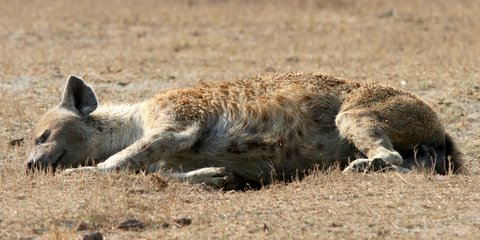 The animals do not seem in the least bothered by human presence; probably because conservation efforts have been on since the beginning of the 20th century, and the animals know that humans here won't harm them; also, with food so abundantly available, they are not interested in humans as prey either.
We spotted the first of the animals whose migration we had also come to see....the WILDEBEEST...here one is, with two CROWNED CRANES flying overhead...
The animals do not seem in the least bothered by human presence; probably because conservation efforts have been on since the beginning of the 20th century, and the animals know that humans here won't harm them; also, with food so abundantly available, they are not interested in humans as prey either.
We spotted the first of the animals whose migration we had also come to see....the WILDEBEEST...here one is, with two CROWNED CRANES flying overhead...
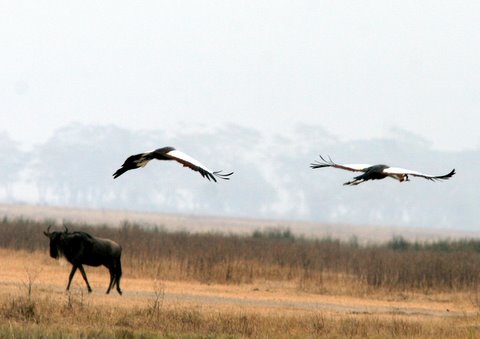 We were lucky enough to catch the tail-end of the migration on the Serengeti Plains..but more about that later!
We then saw this MASAI OSTRICH(male ones have the dark plumage, the females are greyer):
We were lucky enough to catch the tail-end of the migration on the Serengeti Plains..but more about that later!
We then saw this MASAI OSTRICH(male ones have the dark plumage, the females are greyer):
 Off he ran, into the distance, and then we got a sighting that, for us, was one of the highlights of the trip. He met up with a female about a mile away, and the two began plumping up their feathers and dancing around. Huruma said that it was a mating dance, and we were watching, enraptured, when we noticed two other specks on the scene...there were two CHEETAHS taking their ease in the long grass, languidly watching the cultural entertainment the ostriches were putting up!
Please don't be disappointed with this picture, it really WAS very far away!
Off he ran, into the distance, and then we got a sighting that, for us, was one of the highlights of the trip. He met up with a female about a mile away, and the two began plumping up their feathers and dancing around. Huruma said that it was a mating dance, and we were watching, enraptured, when we noticed two other specks on the scene...there were two CHEETAHS taking their ease in the long grass, languidly watching the cultural entertainment the ostriches were putting up!
Please don't be disappointed with this picture, it really WAS very far away!
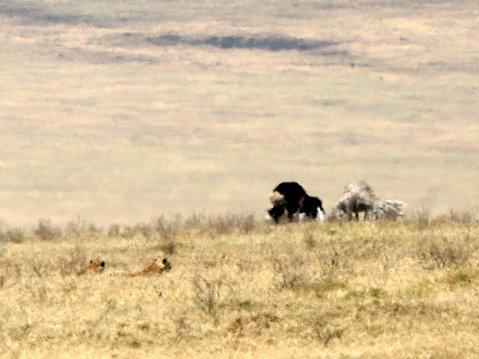 I will be posting the video of this (also somewhat blurry!) to YouTube (2)...
Several more birds, such as the SHRIKE
I will be posting the video of this (also somewhat blurry!) to YouTube (2)...
Several more birds, such as the SHRIKE
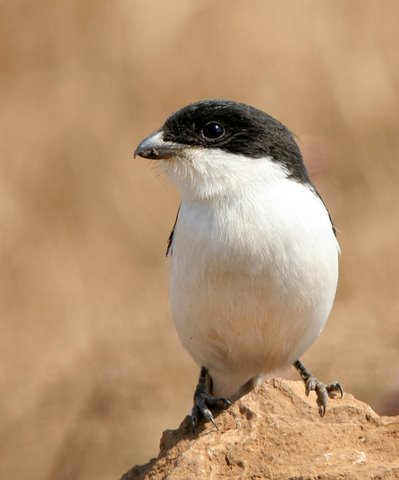 and the common RUFOUS-TAILED WEAVER
and the common RUFOUS-TAILED WEAVER
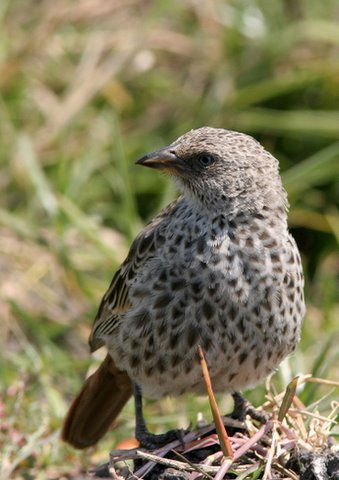 were to be seen, and we kept stopping to take pictures, much to my little nephew's disgust. "BIRDS?" he said. "You take half an hour each time to photograph some BIRDS, when there are cheetahs and leopards and giraffes around?" We had to explain to him that we wouldn't be seeing any giraffes in the NCA...and he was further disgusted!
As if to remind us that these grassy plains were not always a haven of co-existence, we would come across such sights once in a while:
were to be seen, and we kept stopping to take pictures, much to my little nephew's disgust. "BIRDS?" he said. "You take half an hour each time to photograph some BIRDS, when there are cheetahs and leopards and giraffes around?" We had to explain to him that we wouldn't be seeing any giraffes in the NCA...and he was further disgusted!
As if to remind us that these grassy plains were not always a haven of co-existence, we would come across such sights once in a while:
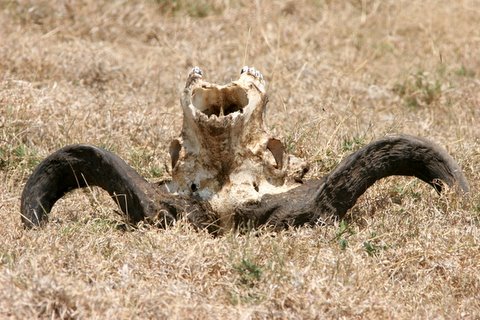 In fact, in a nice touch of humour, many of the signpost walls in Lake Manyara had buffalo skulls set upon them!
True to my luck with mother-and-child sightings, we came across this GOLDEN JACKAL mother with her little cub. The little one got cut off when he wandered into a herd of Zebras, and then the mother caught up with him, and they licked each other's faces so lovingly...that's another YouTube video (3)
In fact, in a nice touch of humour, many of the signpost walls in Lake Manyara had buffalo skulls set upon them!
True to my luck with mother-and-child sightings, we came across this GOLDEN JACKAL mother with her little cub. The little one got cut off when he wandered into a herd of Zebras, and then the mother caught up with him, and they licked each other's faces so lovingly...that's another YouTube video (3)
 We then went closer to the lake, and saw a lot of water-birds (some of which we find in India, too) such as this SPOONBILL
We then went closer to the lake, and saw a lot of water-birds (some of which we find in India, too) such as this SPOONBILL
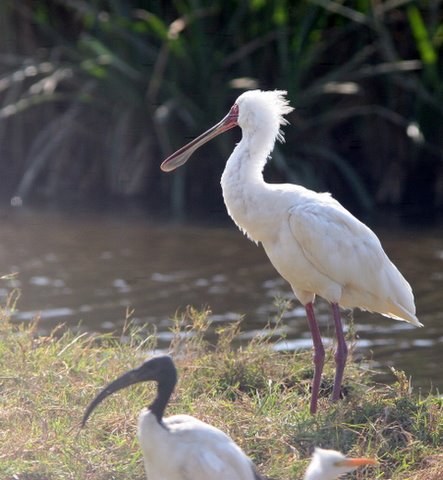 and the SACRED IBIS, which we call the BLACK-HEADED IBIS
and the SACRED IBIS, which we call the BLACK-HEADED IBIS
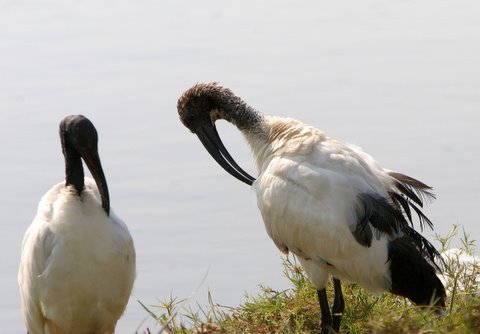 the GREY HERON (that's what we call it here too)
the GREY HERON (that's what we call it here too)
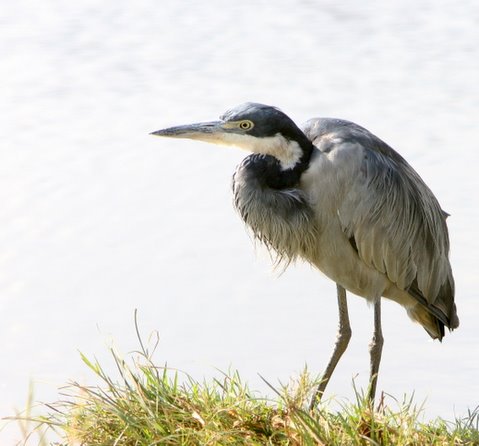 the WHITE PELICAN
the WHITE PELICAN
 the STREAKED WEAVER, sitting in the reeds on the edge of the lake:
the STREAKED WEAVER, sitting in the reeds on the edge of the lake:
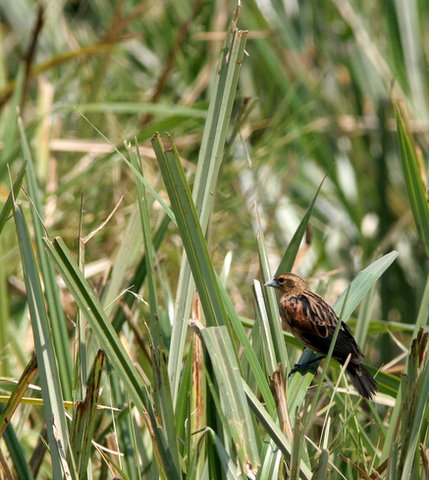 In the distance, we saw this AFRICAN FISHING EAGLE taking off:
In the distance, we saw this AFRICAN FISHING EAGLE taking off:
 and the FLAMINGOES, feeding on the algae in the saltwater of the lake:
and the FLAMINGOES, feeding on the algae in the saltwater of the lake:
 The water's edge had quite a few animals, too, like this AFRICAN BUFFALO with some THOMSON'S GAZELLES:
The water's edge had quite a few animals, too, like this AFRICAN BUFFALO with some THOMSON'S GAZELLES:
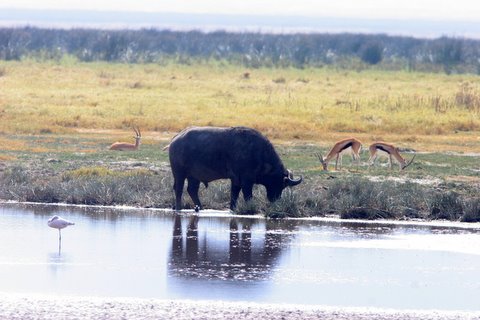 But naturally, the animal that held our eyes was the HIPPOPOTAMUS, of which several were wallowing in the water:
But naturally, the animal that held our eyes was the HIPPOPOTAMUS, of which several were wallowing in the water:
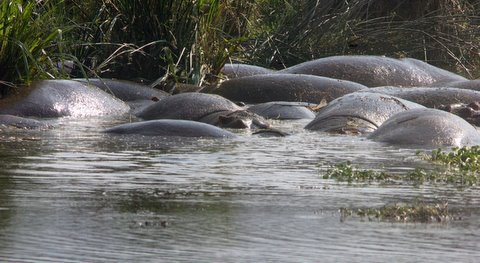 Hippos' skins are covered with a mucus that prevents them from getting sunburnt, but it has to be kept moist, so they must constantly splash water over themselves (talk about needing moisturizer!...They beat us hollow)...but sometimes, in the quest for water, hippos can walk up to ten kilometres from one water body to the next, and so we often found hippos in the grasses, too:
Hippos' skins are covered with a mucus that prevents them from getting sunburnt, but it has to be kept moist, so they must constantly splash water over themselves (talk about needing moisturizer!...They beat us hollow)...but sometimes, in the quest for water, hippos can walk up to ten kilometres from one water body to the next, and so we often found hippos in the grasses, too:
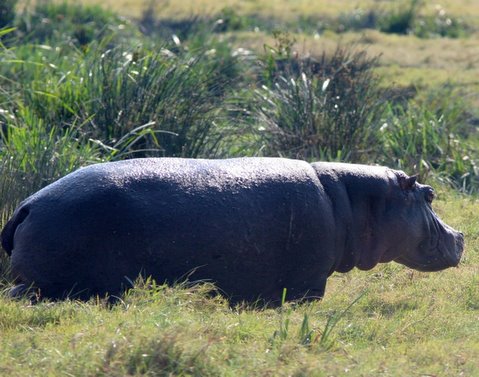 Another bird we kept seeing now and then in the grass was the KORI BUSTARD (the bustard, accofding to Ogden Nash, "is a fowl/That is saved from ignominy/by a single vowel"!):
Another bird we kept seeing now and then in the grass was the KORI BUSTARD (the bustard, accofding to Ogden Nash, "is a fowl/That is saved from ignominy/by a single vowel"!):

Well satisfied with our day’s sightings, we came wearily but happily back to our hotel to tuck into a lot of good food, have hot baths, and …go to sleep in preparation for the 5.30 am start the next day? NO WAY! CF and SD cards had to be downloaded on to the laptop, and one plug-point had to be used in turn to charge all the camera batteries…we couldn’t resist looking up the reference book to see the names of some of the birds once again….no one told us that wildlife was so much hard work!


